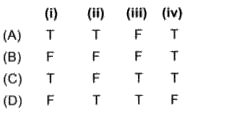MULTIPLE CHOICE QUESTIONS from HT Olympiad Previous Year Paper CHEMICAL REACTIONS AND EQUATIONS for Class 10
| Class 10 | CHEMISTRY |
| Chapter | CHEMICAL REACTIONS AND EQUATIONS |
| HT Olympiad Previous Year Paper | MULTIPLE CHOICE QUESTIONS |
| Medium | English |
| Academic Year | 2023-2024 |
Question 2
A small amount of a light green coloured compound X is heated in a test tube. In the beginning, it loses some water and then gas(es) Z with suffocating smell come(s) out. The vapours of gas(es) are collected and dissolved in water. The solution turns blue litmus red. The residue Y left in the test tube turns reddish brown. X,Y and Z could be respectivelyView SolutionQuestion 3
A small amount of calcium oxide (quick lime) is taken in a beaker. Water is slowly added to this. Which of the following observations is/are incorrect about this activity ?
(i) The beaker becomes hot because it is an endothermic reaction.
(ii) A clear solution is obtained at the top after the reaction gets over.
(iii) This reaction is a combination reaction in which quick lime (CaO) is converted into slaked lime, Ca(OH)2View SolutionQuestion 5
Select the incorrect match(es).
(i) Burning of magnesium ribbon - Combination reaction
(ii) Action of carbon dioxide on quick lime - Combination reaction
(iii) Exposure of silver bromide to light - Decomposition reaction
(iv) Addition of zinc to dilute sulphuric acid - Double displacement reaction
(v) Addition of an acid to a base to form a salt - single displacement reactionView SolutionQuestion 6
A student wrote three statements about rancidity :
I. When fats and oils are reduced, they become rancid.
II. Chips manufacturers usually flush chips bags with oxygen to prevent rancidity.
III. Rancidity is prevented by adding substances called antioxidants to food.
Choose the correct statement(s).View SolutionQuestion 7
Metal X is found in earth's crust. This metal forms a reddish brown substance when exposed to moist air. When a blue coloured solution Y is stored in a container made of X, the solution turns green and a reddish brown metal Z gets deposited on the container. Here X,Y and Z respectively areView SolutionQuestion 10
5 mL of sodium sulphate solution is taken in a test tube and 5 mL of barium chloride solution is taken in another test tube. When the two solutions are mixed slowly and the test tube is left undisturbed for some time, a white precipitate is formed. Which of the following statements is correct about the above reaction ?View SolutionQuestion 13
Four test tubes were taken and marked 1,2,3 and 4 respectively. 2 mL of aqueous solution of aluminium sulphate, Al2(SO4)3, was filled in each test tube. A piece of metal zinc was placed in test tube 1, iron in test tube 2, copper in test tube 3 and aluminium in test tube 4. Mark the correct change in colour in the four test tubes. View Solution
View SolutionQuestion 14
Read the following statements carefully and state (T) for true and (F) for false ones.
(i) All displacement reactions are exothermic reactions.
(ii) All decomposition reactions are endothermic reactions.
(iii) Reaction of water with quick lime is an example of displacement reaction.
(iv) A redox reaction can be a combination reaction also. View Solution
View SolutionQuestion 18
Four students P,Q,R and S noted the initial colour of the solutions kept in beakers I,II,III and IV. After inserting zinc rods in each solution and leaving them undisturbed for two hours, the colour of each solution was again noted in the form of table given below :
Which student noted the colour change in all the four beakers correctly ?View Solution






